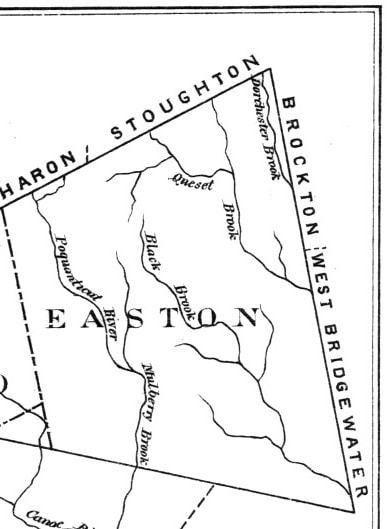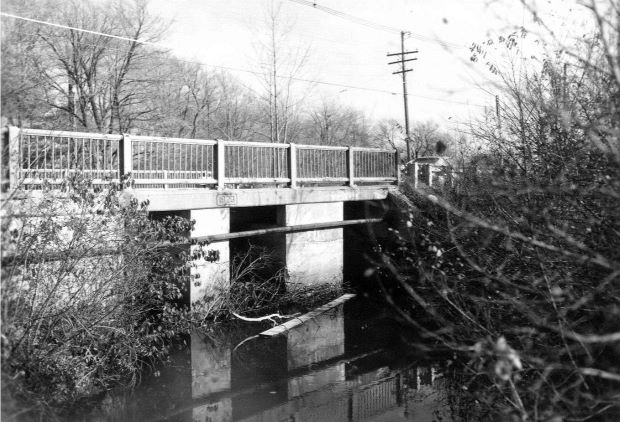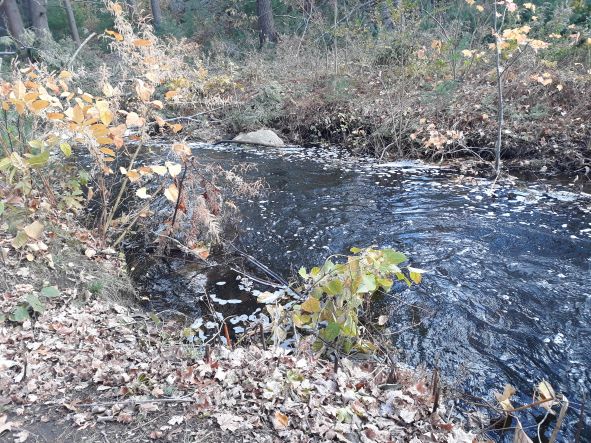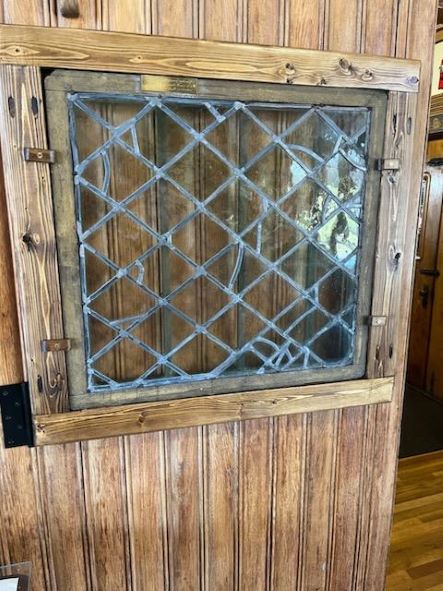|
The Queset The Queset is a lovely brook that runs through the villages of North and South Easton, and on into West Bridgewater, eventually becoming part of the headwaters of the Taunton River. According to Chaffin in the History of Easton, the name Queset was recorded for the first time in 1825. Earlier, the brook was called Mill River, Saw-mill River, Trout-hole Brook, or Brummagem River- after Eliphalet Leonard’s Brummagem Forge. Chaffin believed that Queset was probably a corruption of Cowisset or Coweset, by the people of Bridgewater, who mistook it for another river that was also located in the Taunton North Purchase, but further to the west, in Norton. On a 1736 map Mill River was mistakenly named Cowisset (map from state archives, vol. cxiv. p. 211). Partial view of the map of the Taunton North Purchase showing the main waterways in Easton, including Queset. Today Queset Brook flows out of Ames Long Pond, crossing under Canton Street and going on to meet a tributary formed by the small streams that were at one time (1846-1968) dammed to form Flyaway Pond. After meeting at Picker Field, the combined waters flow west of Canton Street, under Main Street near the Queset House, into Shovel Shop Pond then onto Langwater Pond where it joins Whitman’s Brook flowing south from Easton’s northeast corner. After crossing under Main Street at the Langwater Pond Dam and into Sheep Pasture, flowing south and then east into Morse’s Pond in Easton Center, the Queset continues east under Washington Street, into Dean Pond, and under Turnpike Street to the join with Coweeset Brook near Walnut Street, then travels south to join the Town River in West Bridgewater. Water was of great importance to the early (and later) industries in Easton. A few examples: a saw-mill was built in South Easton sometime before 1700 by Thomas Randall, Sr., Thomas Randall, Jr., and Nathaniel Packard. It was located near the dam on the Queset that existed in Chaffin’s time. (His History of Easton was published in 1886.) Clement Briggs had a grist-mill at the same dam prior to 1713. The third industry known was the Leonard Forge at Stone’s Pond (Fred’s Pond, Langwater) in North Easton. It was working in 1723. In 1716, Capt. James Leonard purchased land on both sides of ‘Trought-hole Brook’ (Queset) to start an iron business. He built a dam, and the business was operational sometime before 1723. Bridge over the Queset at Washington Street, South Easton. Easton Historical Society. The stream gives its name to historic Queset House and Queset Gardens in North Easton and more recently Queset Commons, an apartment complex near Stoneforge Restaurant, and Queset Medical at 20 Roche Bros Way in North Easton. I agree with Chaffin that ‘Queset’, although likely a ‘mistake of a name’, is a pleasant sounding and agreeable name. We live in a different sort of world today; the Queset, and the ponds its dams have created, are enjoyed for their aesthetics more than their practical uses. Queset flowing near Governor Ames Estate. The wind pushes the water Across the pond, over the dam Hard into the granite bones of the Streambed, breaking it black and white Hello Everyone! Of special note on this newsletter: On display now at the Historical Society is this beautiful window brought from England for the Edward Hayward 1714 house. The window is in the Tudor style (1550’s – early 1600’s). The house was southeast of the Joseph Hayward (red) house currently at 227 Foundry Street. According to Ed Hands in Easton’s Neighborhoods, Edward Hayward moved to Easton in 1713 when “the road from West Bridgewater ended at his new house.” He was the first of many Haywards to live in and improve the Hayward-Poole neighborhood. The window is displayed in a special frame crafted by Jon Coe.
1 Comment
Patricia Maguire Parrie
1/2/2023 12:22:56 pm
1/02/2023 - Anne Wooster Drury - I truly enjoy reading your newsletters. So much we never learned/knew about our town back in my schooldays at NEG or OAHS [40s & 50s]. Thank you and the others at the Historical Society who work to teach and preserve our unique hometown's history! A HAPPY & PROSPEROUS NEW YEAR!!
Reply
Your comment will be posted after it is approved.
Leave a Reply. |
Author
Anne Wooster Drury Archives
April 2024
Categories |




